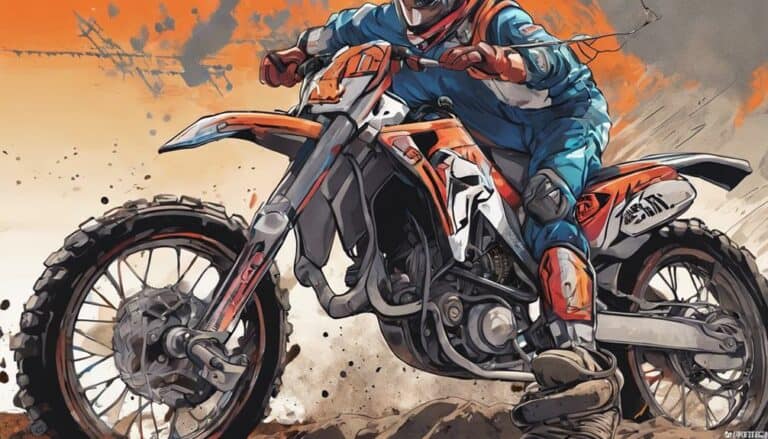If you ride a dirt bike regularly, did you know that a rear shock can lose up to 40% of its damping ability over time? Checking your rear shock is essential for maintaining top performance and safety on the trails.
When it comes to testing your rear shock, there are several key steps you should take to make sure everything is in top condition. From evaluating compression damping to inspecting for wear, each aspect plays an important role in your bike's performance.
Take the time to learn how to test your rear shock properly; it could make all the difference in your next ride.
Key Takeaways
- Check for oil leaks on shock components to prevent damage.
- Test rebound damping for optimal wheel control and traction.
- Evaluate compression damping for a balanced ride experience.
- Verify spring preload to ensure peak performance and handling.
Checking for Oil Leaks
When inspecting a rear shock on a dirt bike for oil leaks, carefully examine the shock body, reservoir, and seals for any signs of leakage. Oil seal inspection is important in troubleshooting potential issues. Look for any leak detection points where oil may be escaping. Signs of oil leaks can indicate wear and tear on the shock components or potential damage that needs maintenance.
To effectively troubleshoot oil leaks, start by checking the shock for any visible oil residue or wetness that could suggest a leak. Addressing these leaks promptly is essential to prevent further damage and maintain the shock's performance. If you notice oil leaks, it may be necessary to service or replace the rear shock to ensure proper function.
Regularly monitoring for oil leaks and promptly addressing them with proper maintenance tips will contribute to the longevity and best performance of your dirt bike's rear shock.
Testing Rebound Damping
To evaluate the rebound damping on a rear shock, compress the shock fully and release it quickly to assess the speed at which it returns to its extended position. A well-functioning shock should extend smoothly and progressively after compression.
If the rebound is too fast, the rear wheel may bounce excessively, causing a harsh ride. Conversely, if the rebound is too slow, it can lead to a pogo-stick effect, reducing traction and control.
To fine-tune the rebound damping, adjust the settings according to your riding style and terrain. Common mistakes when tuning rebound include setting it too fast or too slow, compromising performance.
Troubleshooting tips involve starting with the manufacturer's recommended settings and making incremental adjustments based on your riding experience.
Evaluating Compression Damping
To evaluate the compression damping on a dirt bike's rear shock, firmly push down on the rear of the bike and observe how smoothly and controlled the shock compresses. The compression damping setting determines how the shock reacts to sudden impacts or weight transfer. Ideally, the shock should compress smoothly and progressively without bottoming out harshly.
Adjusting sag, which is the amount the rear suspension settles under the bike's weight, can affect the compression damping. Tuning settings like rebound also play a role in how the shock responds during compression. If the shock compresses too quickly or feels harsh, you may need to adjust the compression damping to achieve a more balanced and controlled ride.
Compare the compression damping of your rear shock to a known good shock to gauge its performance accurately. By fine-tuning the compression damping settings, you can optimize your dirt bike's rear shock for a smoother and more controlled ride.
Inspecting Shock Shaft for Wear
Inspect the shock shaft for wear by looking for signs of scratches, grooves, or pitting, as well as measuring its diameter to check for any out-of-spec dimensions. Proper shaft maintenance is vital for the best performance of your dirt bike's rear shock.
Regular inspection can help troubleshoot any issues before they escalate. To prevent wear, make sure the shock shaft is kept clean and free of debris that could cause damage. Additionally, consider applying protective coatings to minimize the risk of corrosion.
If wear is detected, repair methods may involve polishing out minor imperfections or replacing the shaft if damage is significant. By addressing wear promptly, you can extend the lifespan of your shock components and maintain consistent performance on the trails.
Remember that a well-maintained shock shaft is essential for a smooth and controlled ride, so prioritize this aspect of your dirt bike's upkeep.
Verifying Spring Preload
After examining the shock shaft for wear, the next step in maintaining your dirt bike's rear shock is to verify the spring preload. To do this, you need to measure the sag.
Start by fully extending the rear shock and then sit on the bike in a normal riding position to observe how much the shock compresses. Compare this sag measurement to the manufacturer's recommended sag range for your specific dirt bike model.
Adjusting preload is essential in achieving the correct sag measurement. Tighten or loosen the preload collar on the shock accordingly. Make sure the bike is on level ground and that you're in full riding gear to obtain an accurate measurement of the spring preload.
To test the rear shock, bounce on the seat and observe the rebound. The shock should return smoothly without excessive bouncing or bottoming out. Properly verifying the spring preload guarantees peak performance and handling of your dirt bike.
Conclusion
To sum up, testing the rear shock on your dirt bike is essential for safety and performance.
Did you know that approximately 60% of dirt bike accidents are caused by mechanical failures, including faulty shocks?
By regularly checking for signs of wear and tear, addressing any issues promptly, and following manufacturer recommendations, riders can reduce the risk of accidents and injuries while enjoying a smoother and safer ride.
Remember, safety should always be a top priority in dirt bike maintenance.

